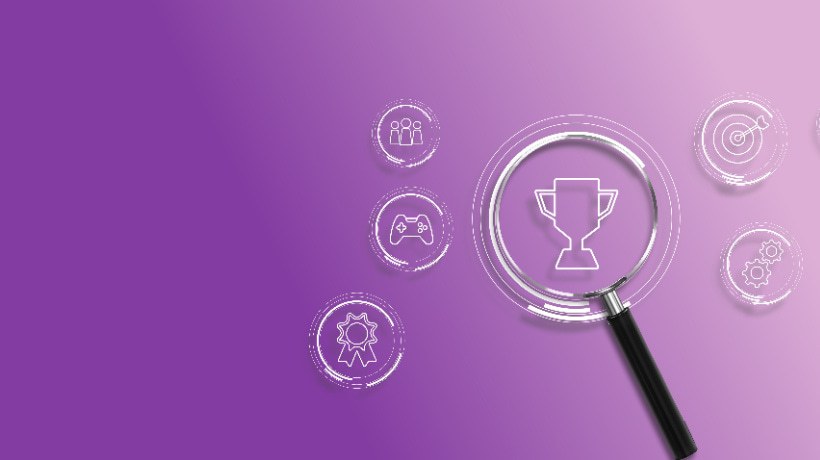What Is Game-Based eLearning?
The theory behind game-based eLearning is that learners learn best when they have goals or targets to reach while also having fun. Game-based eLearning takes the competitive and scoring elements of video games, like points, levels, badges, and leaderboards, and applies them to an instructional context. Elements of game-based learning also include goals, rules, and objectives and can involve conflict, competition, and cooperation.
Another feature includes feedback. Feedback in games and game-based eLearning is almost constant. There are different types of feedback that can enhance game-based learning. Conformational feedback provides learners with immediate feedback about the level of correctness of their response, choice, or activity. Corrective feedback provides guidance, pointing the learner to the correct action or activity. Explanatory feedback provides a detailed explanation of why the answer is correct or incorrect.
Games require a sense of winning or losing, which can be accomplished by:
- Beating other players/teams
- Outperforming the others/teams or beating the system
- Outperforming yourself by improving your performance
Risk and uncertainty are also characteristics of games that make them realistic, appealing, and motivating. Uncertainty can be induced in a game by introducing unexpected events, chance, random responses, or by leaving part of the rules and underlying models implied. Risk can be introduced also by these factors and by using resources or incentives. Participants can lose or acquire resources depending on their own actions, chance, or the actions of others.
An important feature of games is that there is some goal that must be reached. The goal can be:
- To reach the highest level of skill and/or competence
- To solve a particular problem or a series of problems
- To be the best among the competitors
In some games, the subgoals can change during gameplay because the player has reached a certain ability level and advances to a higher level. The goals can be predetermined or set by players.
Why Include Game-Based Learning In Higher Education?
Years of research clearly show that students learn best when they are engaged in active learning. However, the field of higher education still typically maintains the passive practice of lecturing and instructor-led activities.
Game-based learning in higher education improves student attitude, engagement, and performance [1]. There are several aspects of effective instruction that are supported through game-based eLearning. Some of them include scaffolding, purpose, motivation, spaced retrieval, and practice.
Scaffolding
This is the application of educational strategies and techniques to move a learner from their current level of knowledge to the next logical level. Examples include hints, checklists, clues, prompts, and dividing content into small units to aid learning.
Purpose
Purpose, in this context, includes three components: autonomy, competence, and relatedness. The first is that people are motivated when they feel they have a sense of control and are able to determine the outcome of their actions; this is called autonomy.
Second, people are motivated when they feel competent. The content must be set up from least to most difficult. This allows a learner to work their way up to the more difficult information while gaining confidence in their abilities. Following this process provides the learner with a sense of mastery and accomplishment. The most effective design of game-based eLearning is to design the experience in a way that the learner stays at the edge of competence. The content is just the right level of difficulty so the learner feels challenged but not so difficult that they feel they can't master the content.
The final element, relatedness (or social connection), involves elements such as leaderboards or badges to connect one learner to another. People like to experience events with others so they can discuss what happened, compare notes, and reflect with others about their experiences.
Intrinsic Vs. Extrinsic Motivation
Intrinsic motivation is when you do something just for the satisfaction of doing it whereas, extrinsic motivation is when you are motivated by external rewards. Game-based eLearning should strive for a balance between these two types of motivational elements. Use a point or reward system to both motivate the learner and to give them feedback as to how well they perform a task. The points or rewards will be extrinsic motivation and the feedback on performance will be intrinsic motivation. If a task or activity might have a low initial value or interest for the learners, rely more heavily on extrinsic motivation.
If the activity has an initial high value, use feedback, a sense of accomplishment, and self-confidence to motivate the learner. Whenever possible, combine both intrinsic motivational elements, like mastery, opportunities for a series of small successes, and a sense of accomplishment, with extrinsic elements, such as points, badges, and trophies. Keep in mind that different learners may be motivated differently to approach the content. Some may be more intrinsically motivated and some more extrinsically motivated.
Spaced Retrieval And Practice
Game-based eLearning efforts take advantage of the research-based concept of distributed learning. Distributed learning means studying a little bit of content at a time over a long period of time, rather than cramming the content all at once in an eight-hour day, for example.
Learning a little bit at a time means that the learner has time for deeper processing of content and can, therefore, remember it more clearly when asked to recall. Distributed learning is used in many game-based eLearning applications.
Along with that is the idea of retrieval practice, which is basically testing or quizzing the learner throughout the process of learning. The process of having students recall the content creates strong links to the content. Positive results from this technique have been demonstrated with many diverse groups across many diverse ages [2].
Effective Game-Based eLearning Strategies
Start small. You don’t have to implement all the elements of game-based eLearning at one time. You can start by adding digital interactive games to review content and motivate students. The best games are the ones where you can add your own content rather than premade games with content that may not align with or focus on the content your students need most. Some course development software such as Captivate and Lectora include this option.
However, if you do not need to create an entire course or module, Raptivity is an online tool that I use often to create quizzing and review games. It has some simple but effective game interactions such as Balloon Pop, Pizza Mania, Bowling Rush, and more that I can customize in minutes by adding my content. Once you have introduced some games into your course, you could move toward including awards, badges, and leaderboards based on the scores from these games or on other aspects of the course work such as completing all assignments on time, attending class either online or face-to-face according to the schedule, scores on assignments or tests, etc. You can then move to leveling so that students have set goals to move from one level of performance to the next.
Don’t make games too easy or too difficult. This may require creating games with differing levels of content to meet students where they are while encouraging them to increase their knowledge. One three-level approach is to create a demonstration/learning level where a task is demonstrated. The second level would be similar to the first level, but learners are required to complete the task with guidance, tips, and hints. The third level would be where students perform the task on their own.
Have fun designing the games. Think about the games you like to play. What are the features you like? How can you best support student learning through the game? Ask students about what games they play on their phones or tablets and why they like those particular ones.
The impact of game-based education does improve learning. If used well, game-based eLearning can help higher education students learn the skills needed in the workforce, stay engaged in their learning, and meet long-term goals. Jump in and create!
References:
[1] Gamified learning in higher education: A systematic review of the literature.
[2] How to Use Spaced Retrieval Practice to Boost Learning
Additional Resources:
- Why Are Learning Games for Adults More Effective Than Traditional Learning?
- Game-Based Learning And Adult Learning Styles
- How Game-Based Learning is Transforming Adult Education
Raptivity game samples:









![Leveraging An eLearning Gamification Strategy For Your Higher Ed Course [A Guide For L&D]](https://cdn.elearningindustry.com/wp-content/uploads/2020/08/Leveraging-An-eLearning-Gamification-Strategy-For-Your-Higher-Ed-Course.jpg)
